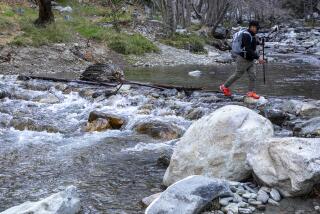Colorado Springs fire evacuation area expands, as Boulder braces
State and fire officials on Wednesday expanded the area around Colorado Springs that needs to be evacuated because of the Waldo Canyon blaze, and pre-evacuation orders were issued for a separate fire near Boulder.
More than 1,000 people were fighting the Waldo Canyon blaze -- the state’s most-threatening fire though not its largest -- and firefighters were bracing for a changing weather pattern that could hinder their efforts. The blaze abruptly doubled in size overnight and has already forced more than 32,000 residents to flee their homes.
The White House announced that President Obama would visit the Colorado Springs area on Friday to view the damage and to thank emergency personnel. Obama also spoke with municipal and state officials about the series of fires in the state, which has been hit especially hard in this fire season.
PHOTOS: Colorado Springs’ Waldo Canyon fire
In the Colorado Springs area, temperatures were lower and winds were calmer Wednesday morning, a far cry from late Tuesday when winds of 65 mph fanned the flames burning at the city’s edge. The Waldo Canyon fire, which began on Saturday, is about 5% contained, fire officials said.
But the weather pattern is expected to change as the afternoon turns into evening, fire information officer Rob Dyerberg said by telephone.
“Mornings are very mellow, but we see changes later in the day as the sun heats up the air currents,” he told the Los Angeles Times. Thunderstorms are expected but they are unlikely to bring enough water to help firefighters. The thunderstorm cells also create other problems.
“We get more and more winds and thunder cells that create erratic winds. It becomes more challenging and more dangerous as the cells of weather pass through,” Dyerberg said.
As a precaution, officials were expanding the evacuation zone ordered on Tuesday, he said.
The expanded zone now includes some of the small communities around Colorado’s second-largest city, Dyerberg said. It was not known how many people would be added to the 32,000 people already ordered or asked, to leave their homes, he said.
More than 2,100 of those people are from 600 homes near the Air Force Academy.
“At this point, it is a guesstimate,” Dyerberg said. He confirmed that some houses have been destroyed by the Waldo Canyon fire, but it was too soon to know the extent of the damage.
Based on the latest estimate, the fire has consumed 15,375 acres, about 24 square miles. The doubling happened quickly as fierce winds drove the blaze toward the city. An estimated 500 to 600 police officers, sheriff’s deputies and emergency workers are assisting the 1,000 firefighting personnel at the scene, Dyerberg said.
The Waldo Canyon fire has already burned about 10 acres at the southwestern edge of the Air Force Academy campus, officials said a news conference on Wednesday. About 90 firefighters were at the scene, according to Lt. Gen. Mike Gould, Air Force Academy superintendent.
Summer classes will continue, he said, and the academy is making plans to process the incoming class of cadets due on Thursday, he said.
Though the fire season is still in its early stages, many Western states have already been hit hard. Record temperatures and a lack of rain have created especially dry fuel conditions, and more than 1.5 million acres of land have been consumed by fires.
Among the states affected have been Arizona, California, Montana, Nevada, New Mexico, Utah and Wyoming. About 29 large active fires are currently being fought, officials said.
Although the Waldo Canyon fire has received the most attention in recent days because of the number of people in possible danger, the biggest blaze in the state is the High Park fire near Fort Collins, north of Denver.
The High Park fire has burned more than 87,000 acres and destroyed 257 homes. One woman has been killed and about 4,300 people forced to flee. Flames are continuing to race farther into expanses of dead trees in the Roosevelt National Forest.
The fire is only 55% contained, but the threatened areas are primarily uninhabited. High Park fire evacuees will be allowed to return home in the next two days, officials said.
Some federal fire crews and equipment that had been battling the fire have begun moving toward other more volatile areas, including the Waldo Canyon fire and the Flagstaff fire near Boulder, according to Kathy Messick, spokeswoman for the Larimer County Sheriff’s Office.
One crew of more than 20 firefighters has moved to Boulder, where a lone mountain separates housing developments from a 230-acre blaze burning without containment. The fire is a mile and a half from the city limits. Local officials have issued pre-evacuation orders, but none was mandatory as of Wednesday afternoon.
Low snowfall, lack of rain and triple-digit temperatures have left dry grasses more susceptible to fire. More than 250 firefighters are battling the Flagstaff blaze from the air because the terrain is too rugged to fight it on foot, the Boulder County Sheriff’s Office told The Times.
Thunderstorms are predicted for overnight. With rain comes high winds.
“That’s the bad news,” spokeswoman Kim Kobel said. “When the winds come, embers can jump a quarter to a half mile ahead and spark spot fires.”
Meanwhile, in Utah, a body was also recovered in the Wood Hollow fire about 100 miles south of Salt Lake City. More than 45,000 acres burned there.
ALSO:Trayvon Martin case: Lead investigator is reassigned
No evidence lesbian couple were targeted, Texas police say
USGS: Sea level in Atlantic ‘hot spot’ rising faster than world’s
Join Laura on Google+ and Twitter @laura_nelson. Email: laura.nelson@latimes.com
Join Michael on Google+. Email: michael.muskal@latimes.com
More to Read
Sign up for Essential California
The most important California stories and recommendations in your inbox every morning.
You may occasionally receive promotional content from the Los Angeles Times.












